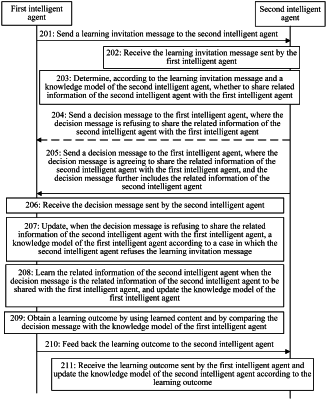| CPC G06N 20/00 (2019.01) [G06F 16/2465 (2019.01); G06N 5/022 (2013.01); G06N 5/043 (2013.01)] | 12 Claims |

|
1. A method for processing information, the method comprising:
performing, by a first intelligent agent in a first terminal device, data mining on a social network, wherein performing the data mining comprises:
autonomously sending, by the first intelligent agent, a request message to a second intelligent agent in a second terminal device, wherein the request message comprises an invitation message or a recommendation message, wherein:
each of the first intelligent agent and the second intelligent agent is a virtual machine learning program and corresponds to a respective user account on the social network; and
the autonomously sending comprises predicting, by the first intelligent agent, an idle time of a second user account by learning a historical activity time of the second user account on the social network, and autonomously sending, by the first intelligent agent, the request message to the second intelligent agent at the idle time of the second user account;
receiving, by the first intelligent agent, a decision message from the second intelligent agent, wherein the decision message is determined by the second intelligent agent according to a knowledge model of the second intelligent agent and the request message; and
updating, by the first intelligent agent according to the decision message, a knowledge model of the first intelligent agent or sending, by the first intelligent agent according to the decision message, a notification message to a first user account corresponding to the first intelligent agent.
|